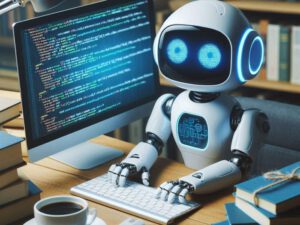
Discover the profound impact of AI on software development. Learn about machine learning, deep learning, NLP, and more. Explore real-life case studies and expert insights. Stay ahead with our comprehensive guide.
Introduction
Overview of AI in Software Development
Artificial Intelligence (AI) has revolutionized the landscape of software development, propelling it into a new era of innovation and efficiency. But what exactly is AI? In simple terms, AI refers to the simulation of human intelligence processes by machines, especially computer systems. These processes include learning (the acquisition of information and rules for using the information), reasoning (using rules to reach approximate or definite conclusions), and self-correction. The evolution of AI in software development is nothing short of spectacular, transitioning from rudimentary algorithms to sophisticated systems capable of learning and improving autonomously.
Why is AI so crucial in today’s software development scene? For starters, it has reshaped the way software is designed, developed, and deployed. Current trends indicate an increasing reliance on AI to enhance various aspects of software development, from code writing to bug detection and user experience personalization. Looking ahead, the future of AI in software development appears even more promising, with projections suggesting further integration and sophistication. The impact on the industry is profound, driving innovation, improving efficiency, and creating new opportunities for developers and businesses alike.
Types and Categories
Machine Learning
Machine learning (ML) is a subset of AI that focuses on the development of algorithms that allow computers to learn from and make predictions based on data. It’s the engine behind many of the AI applications we see today.
- Definition: At its core, machine learning involves training algorithms on a dataset so they can make predictions or take actions without being explicitly programmed to perform those tasks.
- Supervised Learning: This type of machine learning involves training an algorithm on a labeled dataset, meaning the data is tagged with the correct answer. The algorithm makes predictions and is corrected when those predictions are wrong. This process continues until the algorithm achieves a desired level of accuracy.
- Unsupervised Learning: Unlike supervised learning, unsupervised learning works with data that isn’t labeled. The algorithm tries to learn the patterns and the structure from the data by itself. It’s particularly useful for clustering and association tasks.
- Reinforcement Learning: This type of learning involves training algorithms to make a sequence of decisions by rewarding or penalizing them based on the outcomes of their actions. It’s akin to training a pet, where good behavior is rewarded, and bad behavior is discouraged.
Deep Learning
Deep learning is a specialized branch of machine learning that uses neural networks with many layers (hence “deep”) to analyze various factors of data.
- Definition: Deep learning mimics the human brain’s neural networks, with layers of neurons that learn from vast amounts of data.
- Neural Networks: These are the foundation of deep learning, consisting of interconnected layers of nodes (neurons) that process data in complex ways.
- Convolutional Neural Networks (CNNs): CNNs are primarily used in image recognition tasks, excelling in tasks such as object detection and facial recognition.
- Recurrent Neural Networks (RNNs): RNNs are designed for sequential data, making them ideal for tasks such as time series analysis and natural language processing.
Natural Language Processing (NLP)
NLP enables computers to understand, interpret, and respond to human language in a valuable way.
- Definition: NLP combines computational linguistics with machine learning to process and analyze large amounts of natural language data.
- Text Processing: This involves breaking down and interpreting text data, which can be used for tasks such as translation and summarization.
- Speech Recognition: Converting spoken language into text, which has applications in voice-activated assistants and transcription services.
- Sentiment Analysis: Understanding and categorizing the emotions conveyed in a piece of text, commonly used in social media monitoring and customer feedback analysis.
Computer Vision
Computer vision enables computers to interpret and make decisions based on visual data.
- Definition: It involves the automatic extraction, analysis, and understanding of useful information from a single image or a sequence of images.
- Image Recognition: Identifying objects or patterns within an image, which is used in applications ranging from social media to security systems.
- Object Detection: Locating and identifying objects within an image, critical for autonomous vehicles and surveillance systems.
- Facial Recognition: Identifying and verifying individuals based on their facial features, used extensively in security and personalization applications.
Robotics Process Automation (RPA)
RPA involves the use of AI to automate routine, repetitive tasks that were previously done by humans.
- Definition: RPA utilizes software robots or “bots” to emulate human actions within digital systems to execute a business process.
- Applications in Software Development: Automating code reviews, deployment processes, and other repetitive tasks to improve efficiency and reduce errors.
- Benefits and Challenges: While RPA can significantly increase productivity and accuracy, it also poses challenges such as the initial cost of implementation and the need for ongoing maintenance.
Symptoms and Signs
Rapid Prototyping
One of the most noticeable impacts of AI in software development is the ability to rapidly prototype new applications and features.
- Faster Development Cycles: AI-driven tools can automate many aspects of the development process, allowing developers to create and test new features more quickly.
- Reduced Time-to-Market: By streamlining the development process, AI helps businesses bring their products to market faster, gaining a competitive edge.
Improved Code Quality
AI can significantly enhance the quality of code through various means.
- Bug Detection: AI algorithms can analyze code to identify bugs and vulnerabilities more accurately than traditional methods.
- Code Optimization: AI can suggest optimizations that improve performance and efficiency, resulting in cleaner, more efficient code.
Personalized User Experience
AI enables software to adapt to the needs and preferences of individual users, creating more engaging and effective experiences.
- Adaptive Interfaces: AI can adjust the interface and functionality of applications based on user behavior and preferences.
- Predictive Analytics: By analyzing user data, AI can predict future behavior and needs, allowing for more personalized and proactive user experiences.
Enhanced Decision Making
AI empowers developers and businesses to make better decisions by providing data-driven insights.
- Data-Driven Insights: AI can analyze vast amounts of data to uncover patterns and trends that inform decision-making processes.
- Automated Decision Systems: AI systems can make decisions autonomously, based on predefined rules and algorithms, improving efficiency and consistency.
Causes and Risk Factors
Technological Advancements
Several technological factors contribute to the growing impact of AI in software development.
- Increased Computing Power: The advent of powerful GPUs and cloud computing has made it possible to process large datasets and complex algorithms quickly and efficiently.
- Availability of Big Data: The abundance of data generated by digital interactions provides the raw material needed for training sophisticated AI models.
Market Demands
The competitive landscape and evolving market demands drive the adoption of AI in software development.
- Need for Innovation: To stay ahead, businesses must continually innovate, and AI offers a powerful tool for driving such innovation.
- Competitive Advantage: Companies that leverage AI effectively can gain a significant edge over their competitors in terms of efficiency, product quality, and customer satisfaction.
Economic Factors
Economic considerations also play a significant role in the adoption of AI.
- Cost Reduction: AI can automate many tasks, reducing the need for human labor and lowering operational costs.
- Resource Optimization: AI helps businesses optimize the use of resources, improving productivity and profitability.
Regulatory Environment
The regulatory landscape influences the adoption and implementation of AI.
- Compliance Requirements: Regulations around data privacy, security, and ethical AI practices can impact how AI is developed and deployed.
- Ethical Considerations: Businesses must navigate ethical considerations related to AI, such as bias, transparency, and accountability.
Diagnosis and Tests
AI Readiness Assessment
Before implementing AI, it’s crucial to assess the readiness of an organization.
- Organizational Readiness: Evaluating the culture, structure, and processes of the organization to ensure they can support AI initiatives.
- Technical Feasibility: Assessing the existing technical infrastructure and capabilities to determine if they can support AI implementation.
Performance Metrics
Measuring the performance of AI systems is essential for ensuring their effectiveness and efficiency.
- Accuracy: Evaluating the precision of AI predictions and decisions to ensure they meet the desired standards.
- Efficiency: Assessing how quickly and resource-efficiently AI systems perform their tasks.
- Scalability: Ensuring that AI systems can handle increased workloads and scale as needed.
Validation and Verification
Rigorous validation and verification processes are essential to ensure the reliability and trustworthiness of AI systems.
- Testing Frameworks: Utilizing comprehensive testing frameworks to evaluate AI systems under various conditions.
- Benchmarking Tools: Comparing AI performance against established benchmarks to gauge effectiveness and areas for improvement.
Treatment Options
AI Development Tools
Various tools are available to facilitate the development and deployment of AI systems.
- Integrated Development Environments (IDEs): Specialized IDEs provide features and functionalities tailored for AI development.
- Libraries and Frameworks: Popular libraries and frameworks such as TensorFlow, PyTorch, and scikit-learn simplify the development of AI models.
AI Integration Techniques
Integrating AI into existing systems and workflows requires specialized techniques.
- APIs: Application Programming Interfaces (APIs) allow AI capabilities to be easily integrated into other software systems.
- Microservices: Breaking down applications into smaller, manageable services makes it easier to incorporate AI components.
Continuous Learning Systems
AI systems must continually learn and adapt to remain effective.
- Model Updates: Regularly updating AI models with new data ensures they remain accurate and relevant.
- Feedback Loops: Incorporating user feedback helps AI systems improve over time, becoming more effective and user-friendly.
Collaboration Platforms
Effective collaboration tools are essential for managing AI development projects.
- Version Control: Tools like Git help manage changes to AI models and code, ensuring version control and collaboration.
- Project Management Tools: Platforms like Jira and Trello facilitate project management, ensuring that AI development projects are well-organized and on track.
Preventive Measures
Best Practices in AI Implementation
Adhering to best practices is crucial for the successful implementation of AI.
- Ethical AI: Ensuring that AI systems are developed and used ethically, avoiding biases and ensuring fairness.
- Bias Mitigation: Implementing strategies to identify and mitigate biases in AI systems, ensuring they are fair and equitable.
Ongoing Training and Education
Continuous education is essential to keep up with the rapidly evolving field of AI.
- Skill Development: Offering training programs and workshops to help developers and other stakeholders enhance their AI skills.
- Certification Programs: Providing certification programs to validate and recognize AI expertise.
Robust Security Measures
Ensuring the security of AI systems is paramount.
- Data Privacy: Implementing robust data privacy measures to protect user data and comply with regulations.
- Cybersecurity: Protecting AI systems from cyber threats and attacks through comprehensive security measures.
Regular Audits and Reviews
Regular audits and reviews help maintain the effectiveness and compliance of AI systems.
- Performance Audits: Conducting regular performance audits to ensure AI systems are functioning as intended.
- Compliance Checks: Ensuring AI systems comply with relevant regulations and ethical standards through regular compliance checks.
Personal Stories or Case Studies
Case Study: AI in Fintech
AI has made significant strides in the financial technology (fintech) sector.
- Improved Fraud Detection: AI algorithms can analyze transactions in real-time, identifying and preventing fraudulent activities with greater accuracy.
- Personalized Banking: AI-powered chatbots and recommendation systems offer personalized banking experiences, enhancing customer satisfaction.
Case Study: AI in Healthcare
AI is transforming the healthcare industry, improving patient outcomes and operational efficiency.
- Enhanced Diagnostics: AI algorithms can analyze medical images and data, providing more accurate and timely diagnoses.
- Predictive Patient Care: AI systems can predict patient outcomes and recommend preventive measures, improving overall patient care.
Case Study: AI in Retail
The retail industry has embraced AI to enhance various aspects of operations and customer experience.
- Inventory Management: AI systems can predict demand and optimize inventory levels, reducing costs and improving efficiency.
- Customer Service Chatbots: AI-powered chatbots provide instant customer support, improving customer satisfaction and reducing the burden on human agents.
Case Study: AI in Manufacturing
AI is driving significant improvements in manufacturing processes and product quality.
- Predictive Maintenance: AI systems can predict equipment failures, allowing for proactive maintenance and reducing downtime.
- Quality Control: AI-powered inspection systems can detect defects and ensure product quality, reducing waste and improving customer satisfaction.
Expert Insights
Quotes from Industry Leaders
Industry leaders provide valuable insights into the impact and future of AI in software development.
- Insights from AI Pioneers: Leading figures in AI development share their perspectives on the current state and future of AI.
- Perspectives from Software Developers: Experienced developers discuss how AI has transformed their work and the software development process.
Academic Perspectives
Academics offer research-based insights into the evolving field of AI.
- Research Findings: Recent research highlights the latest advancements and discoveries in AI.
- Future Trends: Academics discuss potential future developments and trends in AI.
Conclusion
In summary, the impact of AI on software development is undeniably transformative, ushering in a new era of innovation and efficiency. AI’s integration into the development lifecycle enhances everything from rapid prototyping and improved code quality to personalized user experiences and data-driven decision-making. However, along with its benefits, AI brings challenges such as ethical considerations, bias mitigation, and the need for continuous learning and robust security measures. As we look to the future, it’s clear that AI will continue to shape and redefine the software industry, making it essential for developers, businesses, and policymakers to stay informed and engaged with the latest advancements and trends. By embracing AI and its potential, we can drive forward the next generation of software solutions that are smarter, more efficient, and tailored to the needs of users worldwide.







